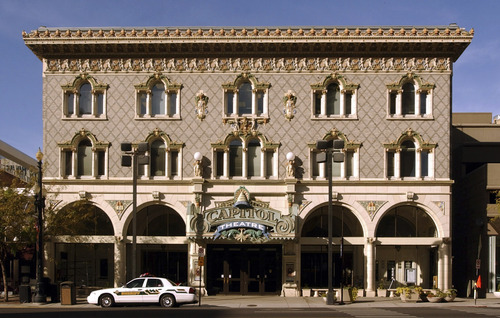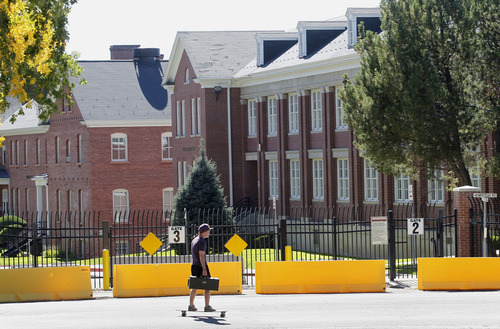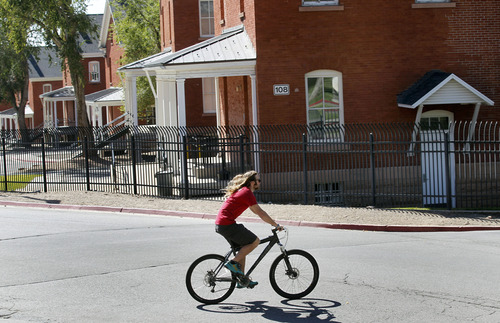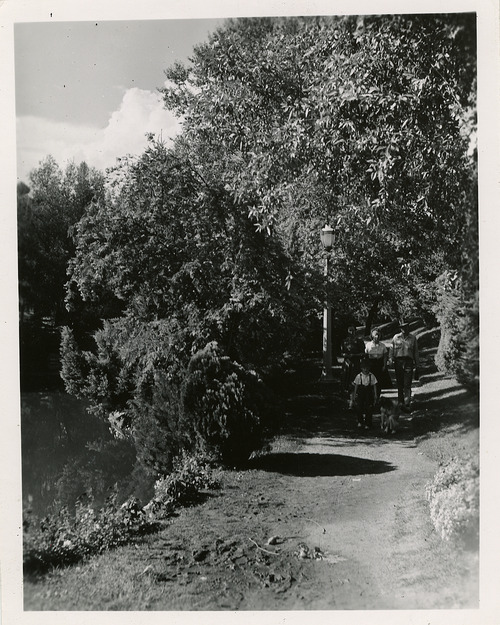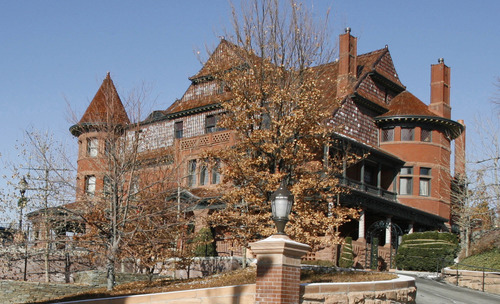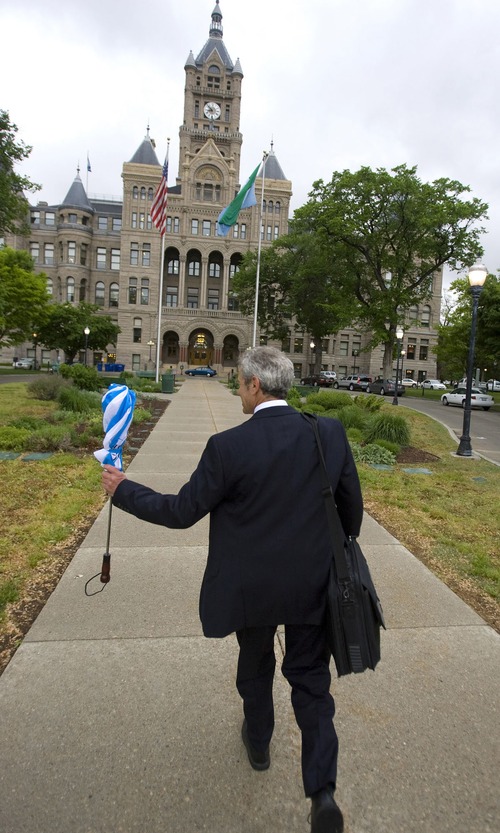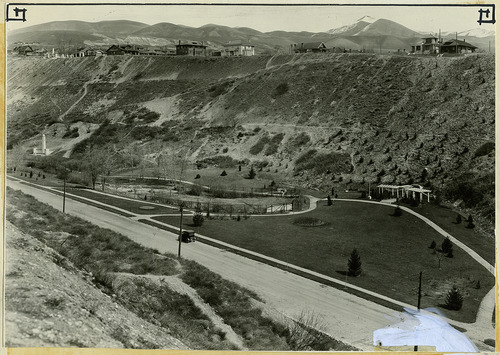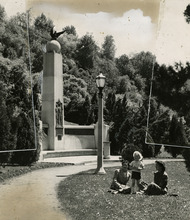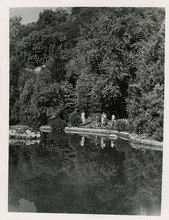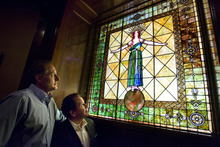This is an archived article that was published on sltrib.com in 2012, and information in the article may be outdated. It is provided only for personal research purposes and may not be reprinted.
When it comes to tales of the paranormal, City Hall isn't unique. Stories about hauntings in the northern end of Utah's capital city stretch from downtown to Memory Grove to the city cemetery that overlooks the Salt Lake Valley.
Here are 10 such places scattered around the northern end of the city, along with brief explanations of the urban legends and/or documented events gathered from newspaper archives, the Utah Historical Society and Grimm Ghost Tours. Believe it or not.
1. Rio Grande Depot • (300 S. Rio Grande St.) The historic depot, which opened in 1911, is supposedly home to several ghosts — the most famous being the Purple Lady. There are several versions of the story, but all agree that a beautiful woman (perhaps named Gloria) and her fiancé argued on the train platform. One of them threw her engagement ring onto the tracks; the Purple Lady was hit and killed by a train when she tried to retrieve it. In another version of the story, it was her fiancé who pushed her.
Open to the public? • The Utah State Historical Society at the Rio Grande Depot is open Monday-Friday from 9 a.m.-4 p.m.
2. City Hall • (451 S. State St.) This building, which opened in 1894, houses as many as five ghosts, including two children reportedly killed while playing there, as well as their heartbroken mother. And some claim a former Salt Lake mayor — possibly George Montgomery Scott or Robert Newton Baskin — roams the halls above, while the ghosts of prisoners and/or guards haunt the underground tunnel below the building.
Open to the public? • 8 a.m.-5 p.m., Monday-Friday
3. Capitol Theatre • (50 W. 200 South) Built in 1913 and restored in 1978, this downtown theater has a long history as a vaudeville house, a movie theater and a performing-arts center. It's also said to be host to a variety of ghosts, including women in period costumes, malevolent forces and perhaps a misbehaving teenager popularly known as George. There's no record of a George, but Salt Lake Tribune archives record that 17-year-old theater usher Richard L. Duffin was killed during a fire at the theater in 1949.
Open to the public? • During performances, with a valid ticket.
4. Shilo Inn • (206 S. West Temple) A child or children are said to haunt the hotel, particularly the 11th floor and the pool area, and the disembodied laughter of a woman is sometimes heard. Most of the stories indicate the children are playful, rather than malevolent, but one story has it that a female hotel guest was found drowned in the pool with unidentified, child-sized wet footprints around her. On Aug. 3, 1978, Rachel David threw her seven children off an 11th-floor balcony at what was then the International Dunes Inn, then jumped to her own death. Only one of the David children survived.
Open to the public? • Only to paying guests. Hotel management discourages interest.
5. Salt Lake City Cemetery — Lilly E. Gray grave • (200 N St.) The eerie inscription on the headstone has drawn much attention: "Lilly E. Gray, June 6, 1881-Nov. 14, 1958, Victim of the Beast 666." And there are reports of a ghostly presence at the site. Yet research by Richelle Hawks indicates not all is what it seems. Seems the deceased's name is spelled wrong (Lily, not Lilly); and her actual birthdate is June 4, 1880. Hawkes postulates that the weird message on the headstone may have been put there by her husband, Elmer L. Gray, who was himself a colorful character.
Open to the public? • 8 a.m.-dusk, 365 days a year.
6. Salt Lake Cemetery — Jacob E. Moritz tomb • (200 N St.) Legend has it that if you circle the tomb chanting, "Emo, Emo, Emo" — apparently derived from Jacob EMO-ritz — and then look into the barred window, you'll see either the glowing red eyes or ghostly face of its inhabitant. The story goes that Moritz was some kind of devil worshipper who was burned at the stake by outraged Salt Lakers. Actually, Moritz was a German immigrant who founded Salt Lake Brewing Co., got rich, was involved in Utah politics, helped draft the Utah Constitution and died on a trip to Germany in 1909.
There's some dispute as to whether his ashes were shipped back to Utah and placed in the tomb, but the legend that has grown up around his tomb seems in no way related to the facts of Moritz's life.
Open to the public? • 8 a.m.-dusk, 365 days a year.
7. Devereaux Mansion • (334 W. South Temple) There are tales of the ghost of a young girl who can be seen in the windows of the mansion, which was built in 1857. She sometimes throws things and slams doors. Also, a young man is thought to haunt the premises.
Open to the public? • No. It's a private reception facility.
8. McCune Mansion • (200 N. Main St.) A pair of ghosts are reported to inhabit the home — a man in a black cape and a young girl in white, who is said to resemble a girl in a portrait found in the house. Items are said to move around the house with no explanation.
Open to the public? • No. It's a private reception facility.
9. Fort Douglas • (32 Potter St., University of Utah campus) The spirit of a Civil War-era soldier, known as Clem, is said to haunt the museum. Reports include everything from feeling cold breath on the back of one's neck to full-body apparitions. Fort Douglas dates to 1862, and there are plenty of documented deaths of soldiers from the mid-19th century on.
Hauntings at Fort Douglas are the subject of Brian Jackson Fetzer's film "The Ghostly Guardians," which will be screened at the Salt Lake Freedom Film and Storytelling Festival on Saturday, Nov. 10, at 3:30 p.m. in the Fort Douglas Post Theater, 245 South Fort Douglas Blvd., U. campus, Salt Lake City.
Open to the public? • Tuesdays-Fridays, noon-5 p.m. (except for Thanksgiving and Christmas).
10. Memory Grove • (300 N. Canyon Road) The story most frequently repeated about this city-owned park tells of a female ghost who was killed in a car accident in the 1930s or 1940s there just before her wedding.
Open to the public? • Dawn to dusk.
Scott D. Pierce


